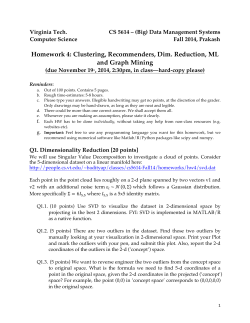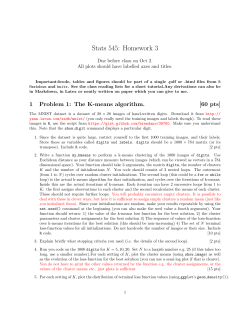
Lecture01_K-means+EM..
Clustering Techniques
K-Means & EM
Mario Haddad
What is Clustering?
Cluster: a collection of data objects
Similar to one another within the same cluster
Dissimilar to the objects in other clusters
Clustering is unsupervised classification:
no predefined classes
Typical applications
As a stand-alone tool to get insight into data
distribution
As a preprocessing step for other algorithms
K-Means
K-Means
Groups data into K clusters and attempts
to group data points to minimize the sum
of squares distance to their central mean.
Algorithm works by iterating between two
stages until the data points converge.
Problem Formulation
Given a data set of {x1,…,xN} which
consists of N random instances of a
random D-dimensional Euclidean variable
x.
Introduce a set of K prototype vectors, µk
where k=1,…,K and µk corresponds to the
mean of the kth cluster.
Problem Formulation
Goal is to find a grouping of data points
and prototype vectors that minimizes the
sum of squares distance of each data
point.
Problem Formulation (cont.)
This can be formalized by introducing an
indicator variable for each data point:
rnk
is {0,1}, and k=1,…,K
Our objective function becomes:
𝑁
𝐾
𝑟𝑛𝑘 | 𝑥𝑛 − 𝜇𝑘 |2
𝐽=
𝑛=1 𝑘=1
How K-Means works
Algorithm initializes the K prototype
vectors to K distinct random data points.
Cycles between two stages until
convergence is reached.
Convergence: since there are only a finite
set of possible assignments.
How K-Means works
1. For each data point, determine rnk where:
𝑟𝑛𝑘
1
=
0
𝑖𝑓 𝑘 = 𝑎𝑟𝑔𝑚𝑖𝑛𝑗 | 𝑥𝑛 − 𝜇𝑘 |2
𝑜𝑡ℎ𝑒𝑟𝑤𝑖𝑠𝑒
2. Update µk :
𝜇𝑘 =
𝑛 𝑟𝑛𝑘 𝑥𝑛
𝑛 𝑟𝑛𝑘
How K-Means works (cont)
If k (number of clusters) and d (dimension
of variables) are fixed, the clustering can
be performed in time.
𝑂(𝑁
𝑑𝑘+1
𝑙𝑜𝑔𝑁)
Exponential bounds for plane: 𝑂(𝑁 𝑘𝑑 )
K-Means
Initialization example
Pick K cluster centers (unfortunate choice)
K-Means
Initialization example
Pick K cluster centers (random choice)
K-Means++
K-Means with smart initial seeding
Choose one center uniformly at random from among the data
points.
For each data point x, compute D(x), the distance
between x and the nearest center that has already been
chosen.
Choose one new data point at random as a new center, using a
weighted probability distribution where a point x is chosen
with probability proportional to D(x)2.
Repeat Steps 2 and 3 until k centers have been chosen.
Now that the initial centers have been chosen, proceed using
standard k-means.
K-Means++
This seeding method yields considerable
improvement in the final error of k-means
Takes more time to initialize
Once initialized, K-Means converges quickly
Usually faster than K-Means
1000 times less prone to error than K-Means
K-Means Example
Cluster black and white intensities:
Intensities: 1 3 8 11
Centers c1 = 7, c2=10
Assign 1, 3, 8 to c1, 11 to c2
Update c1 = (1+3+8)/3 = 4, c2 = 11
Assign 1,3 to c1 and 8 and 11 to c2
Update c1 = 2, c2 = 9 ½
Converged
K-Means
Image
Computer Vision - A Modern Approach
Set: Segmentation
Slides by D.A. Forsyth
Clusters on intensity
K-Means
Original:
After
Intensity
Clustering:
K-means using color alone,
11 segments.
Computer Vision - A Modern Approach
Set: Segmentation
Slides by D.A. Forsyth
K-means using color and
position,20 segments.
Computer Vision - A Modern Approach
Set: Segmentation
Slides by D.A. Forsyth
Pros and Cons of K-Means
Convergence: J may converge to a local minima and
not the global minimum. May have to repeat algorithm
multiple times.
With a large data set, the Euclidian distance
calculations can be slow.
K is an input parameter. If K is inappropriately chosen
it may yield poor results.
Local Minima
K-Means might not find the best possible
assignments and centers.
Consider points 0, 20, 32.
K-means can converge to centers at 10, 32.
Or to centers at 0, 26.
Heuristic solutions
Start with many random starting points and
pick the best solution.
EM
Expectation Maximization
Soft Clustering
Clustering typically assumes that each instance is
given a “hard” assignment to exactly one cluster.
Does not allow uncertainty in class membership or
for an instance to belong to more than one cluster.
Soft clustering gives probabilities that an instance
belongs to each of a set of clusters.
Each instance is assigned a probability distribution
across a set of discovered categories (probabilities
of all categories must sum to 1).
EM
Tends to work better than K-Means.
Soft Assignments
A point is partially assigned to all clusters.
Use probabilistic formulation
Mixture of Gaussians
g(x; m, σ)
The probability of a point x based on a
Gaussian Distribution with mean m and
variance σ
Intuition
A mixture of K Gaussians
A distribution generated by randomly
selecting one of K Gaussians, then randomly
draw a point from that distribution.
Gaussian k with a probability of pk
Goal: find pk, σk, mk that maximize the
probability of our data points.
Back to EM
Iterative Algorithm
Goal: group some primitives together
Chicken and Egg problem:
Items in group -=> Description of the group
Description Of the group -=> Items in
group
Brace Yourselves..
EM
Iterative Algorithm: E Step and M Step
E Step:
Compute the probability that point n is
generated by distribution k
𝑝
𝑖
𝑘𝑛 =
𝑖
𝑝𝑘
𝑖
𝑖
𝑔(𝑥𝑛 ; 𝑚𝑘 , 𝜎𝑘 )
(𝑖) (𝑖)
𝑖
𝐾
𝑚=1 𝑝𝑘 𝑔(𝑥𝑛 ; 𝑚𝑘 , 𝜎𝑘 )
EM
M Step:
(𝑖+1)
𝑚𝑘
=
(𝑖+1)
𝜎𝑘
=
(𝑖+1)
𝑝𝑘
1
=
𝑁
𝑁
(𝑖) (𝑘|𝑛)𝑥
𝑝
𝑛
𝑛=1
𝑁
(𝑖) (𝑘|𝑛)
𝑝
𝑛=1
1
𝐷
𝑁
𝑖
𝑝
𝑛=1
𝑘 𝑛 ||𝑥𝑛 −
(𝑖+1) 2
𝑚𝑘
||
𝑁
(𝑖)
𝑛=1 𝑝 (𝑘|𝑛)
𝑁
𝑛=1
𝑝(𝑖) (𝑘|𝑛)
EM
Converges to a locally optimal solution
Each step increases the probability of the
points given the distributions.
Can get stuck in local optima
(less than K-Means)
EM vs K-Means local optima
1D points at 0 20 32
Centers at 10 and 32
A local minima for k-means
EM: 20 almost evenly shared between the
two centers.
The center at 32 moves closer to 20 and
takes over
First center shifts to the left.
EM and K-means
Notice the similarity between EM for Normal
mixtures and K-means.
The expectation step is the assignment.
The maximization step is the update of centres.
K-means is a simplified EM.
K-means makes a hard decision while EM makes a
soft decision when updating the parameters of the
model.
EM and K-Means
K-Means
𝑟𝑛𝑘
1
=
0
EM
𝑝
𝑖
𝑘𝑛 =
𝑖𝑓 𝑘 = 𝑎𝑟𝑔𝑚𝑖𝑛𝑗 | 𝑥𝑛 − 𝜇𝑘 |2
𝑜𝑡ℎ𝑒𝑟𝑤𝑖𝑠𝑒
𝑖
𝑝𝑘
𝑖
𝑖
𝑔(𝑥𝑛 ; 𝑚𝑘 , 𝜎𝑘 )
(𝑖) (𝑖)
𝑖
𝐾
𝑚=1 𝑝𝑘 𝑔(𝑥𝑛 ; 𝑚𝑘 , 𝜎𝑘 )
EM and K-Means
K-Means
𝜇𝑘 =
𝑛 𝑟𝑛𝑘 𝑥𝑛
𝑛 𝑟𝑛𝑘
EM
(𝑖+1)
𝑚𝑘
=
𝑁
(𝑖)
𝑝
(𝑘|𝑛)𝑥𝑛
𝑛=1
𝑁
(𝑖) (𝑘|𝑛)
𝑝
𝑛=1
Fast Image Segmentation Based on
K-Means Clustering with
Histograms in HSV Color Space
HSV
Hue-Saturation-Value
Overview
Histogram Generation
Motivation
Gray and color histograms in HSV color
space for K-Means clustering
Cluster number automatically set by
“Maximin” initialization
Fast and efficient to extract regions with
different colors in images.
Segmentation results are close to human
perceptions.
Maximin Initialization and
Parameter Estimation
Use Maximin to initialize number of
clusters and centroid positions:
Step A: From the color histogram bins and
gray histogram bins, find the bin which
has the maximum number of pixels to be
the first centroid.
Maximin Initialization and
Parameter Estimation
Step B: For each remaining histogram bin,
calculate the min distance, which is the
distance between it and its nearest
centroid. Then the bin which has the
maximum value of min distance is chosen
as the next centroid.
Step C: Repeat the process until the
number of centroid equals to KMax or the
maximum value of the distance in Step B
is smaller than a predefined threshold
ThM.
Maximin Initialization and
Parameter Estimation
Kmax is set to 10.
There should be no more than 10 dominant
colors in one image for high level image
segmentation.
ThM is set to 25.
According to human perception of different
colors in HSV color space.
K-Means Clustering in HSV
Color Space
Step 1: Estimate the parameters of KMeans.
Step 2: Two kinds of histogram bins will
be clustered together in this step. For
color histogram bins, since the hue
dimension is circular (e.g. 0◦ = 360◦), the
numerical boundary should be considered
in the distance measurement and the
process of centroid calculations.
K-Means Clustering in HSV
Color Space
For gray histogram bins, there is no hue
information inside. which means that the
saturation values of gray histogram bins
are all considered as zero, and the hue
values can be arbitrary.
K-Means Clustering in HSV
Color Space
K-Means Clustering in HSV
Color Space
Step 3: Recalculate and update K cluster
centroids. Again, since the hue dimension
is circular, the indices in the hue
dimension should be considered not
absolutely but relatively.
K-Means Clustering in HSV
Color Space
Step 4: Check if the clustering process is
converged according to the total
distortion measurement, which is the
summation of distances between each
histogram bin and its nearest cluster
centroid
When the difference of total distortion
measurement is smaller than a predefined
threshold or max iterations reached,
terminate. Else, go to step 2
K-Means Clustering in HSV
Color Space
Step 4 intuition:
G(v) represents the number of pixels in
the gray histogram bin with parameter v
B(h, s, v) represents the number of pixel
in the color histogram bin with
parameters (h, s, v)
K-Means Clustering in HSV
Color Space
Step 5: Image pixels are labeled with the
index of nearest centroid of their
corresponding histogram bins. A labeled
image is obtained in this step, and KMeans clustering is finished.
K-Means Clustering in HSV
Color Space
Eliminate noise and unnecessary details of
labeled images
Statistical filter
Windows over pixels
The purpose of this filter is to replace the
pixel in the labeled image with the label
with maximum number in a window.
Areas smaller than a certain threshold are
merged with biggest neighboring region to
avoid over segmentation
K-Means Clustering in HSV
Color Space
Summary
Clustering
K-Means
K-Means++ initialization
EM
EM as a general K-Means
Fast Image Segmentation Based on KMeans Clustering with Histograms in HSV
Color Space
Thank You For
Listening
References
Fast Image Segmentation Based on K-Means Clustering
with Histograms in HSV Color Space Tse-Wei Chen 1, YiLing Chen 2, Shao-Yi Chien
K-Means and EM - David Jacobs
D. Forsyth
Expectation-Maximization Algorithm and Image
Segmentation - Daozheng Chen
© Copyright 2025












